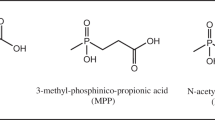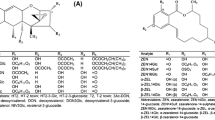Abstract
A simple method for the simultaneous determination of glufosinate and its metabolites in plants based on liquid chromatography–ultraviolet (LC–UV) absorption detection after derivatization with fluorenylmethoxycarbonyl chloride (FMOC-Cl) of some analytes to facilitate separation is reported here. Nonavailable standard metabolites were identified by LC–TOF/mass spectrometry (MS), which also confirmed all target analytes. Ultrasound-assisted extraction was used for sample preparation (power of 70 W and duty cycle of 0.7 s/s for 10 min) with subsequent evaporation of the extractant, reconstitution and filtration as the cleanup/concentration step prior to derivatization, and chromatographic separation and detection at 270 nm for underivatized analytes and 340 nm for those that were derivatized. The chromatographic analysis was completed in 40 min using a Luna® column (C18 phase). The analytical characteristics of the method were linear dynamic range of the calibration curves within 0.047–700 μg/mL with a regression coefficient (rc) of 0.999 for glufosinate, 0.077–700 μg/mL with a rc of 0.998 for N-acetyl-glufosinate, and 0.116–600 μg/mL with a rc of 0.998 for 3-(methylphosphinico)propanoic acid. The precision for the determination of glufosinate (studied at two levels, 0.1 and 5 μg/mL) was 2.7 and 6.0 % for repeatability and 4.7 and 7.2 % for within-laboratory reproducibility, respectively. Identification and confirmatory analysis of the presence of glufosinate and metabolites in the extracts from treated plants was carried out by LC–TOF/MS in high-resolution mode for the precursor ion. The method was validated by analyzing wheat (Triticum aestivum) samples (resistant and susceptible biotypes) treated with 300 g of glufosinate/ha following conventional agronomical practices.



Similar content being viewed by others
References
Bayer E, Gugel KH, Hagele K, Hagenmaier H, Jessipow S, Konig WA, Zahner HR (1972) Stoffwechselprodukte von mikroorganismen. Phosphinothricin und phosphinothricin-alanyl-alanin. Helv Chim Acta 55:224–239
Lea PJ, Joy KW, Ramos JL, Guerrero MG (1984) design and synthesis of potent inhibitors of glutamine synthetase. Phytochemistry 23:1–6
Hoagland RE (2000) In: Cutler HG, Cutler SJ (eds) Biochemical interactions of the microbial phytotoxin phosphinothricin and analogs with plants and microbes. Active natural products. CRC, Boca Raton
Tachibana K, Watanaba T, Seikizawa Y, Takematsu T (1986) Accumulation of ammonia in plants treated with bialaphos. J Pestic Sci 11:33–37
Sauer H, Wild A, Rühle W (1987) The effect of phosphinothricin (glufosinate) on photosynthesis. 11. The causes of inhibition of photosynthesis. Z Naturforsch 42:270–287
Hoerlein G (1994) Glufosinate (phosphinothricin), a natural amino acid with unexpected herbicidal properties. Rev Environ Contam T 138:73–145
Ávila-García WV, Sánchez-Olguin E, Hulting AG, Mallory-Smith C (2012) Target-site mutation associated with glufosinate resistance in Italian ryegrass (Lolium perenne L. ssp. multiflorum). Pest Manag Sci 68:1248–1253
Wehrmann A, Van Vliet A, Opsomer C, Botterman J, Schulz A (1996) The similarities of bar and pat gene products make them equally applicable for plant engineers. Nat Biotechnol 14:1274–1278
Wohlleben W, Arnold W, Broer I, Hillermann D, Strauch E, Puhler A (1988) Nucleotide sequence of the phosphinothricin N-acetyltransferase gene from Streptomyces viridochromogenes TÜ 494 and its expression in Nicotiana tabacum. Gene 70:25–37
Haas P (1986) Verhalten von glufosinate-ammonium in unkrautem. inaugural dissertation number 53. University of Hohenheim, Stuttgart, Germany
Dröge W, Broer I, Pühler A (1992) Transgenic plants containing the phosphinothricin-N-acetyltransferase gene metabolize the herbicide phosphinothricin (glufosinate) differently from untransformed plants. Planta 187:142–151
Dröge W, Siemeling U, Pühler A, Broer I (1994) The metabolites of the herbicide L-phosphinothricin (glufosinate). Identification, stability and mobility in transgenic, herbicide-resistant and untransformed plants. Plant Physiol 105:159–166
Jansen C, Schuphan I, Schmidt B (2000) Glufosinate metabolism in excised shoots and leaves of twenty plant species. Weed Sci 48:319–326
Suzuki A, Kawana M (1989) Rapid and simple method for identification of glufosinate-ammonium using paper chromatography. Bull Environ Contam Toxicol 43:17–21
Sancho JV, López FJ, Hernández F, Hogendoorn EA, Van Zoonen P (1994) Rapid determination of glufosinate in environmental water samples using 9-fluoronylmethoxycarbonyl precolumn derivatization, large-volume injection and coupledcolumn liquid chromatography. J Chromatogr A 678:59–67
Akuzawa H, Akaiwa H (1997) Rapid determination of DL-homoalanin-4-yl-(methyl)phosphinic acid by high-performance liquid chromatography with fluorescence detection. Bunseki Kagaku 46:69–74
Hori Y, Fujisawa M, Shimada K, Sato M, Kikuchi M, Honda M, Hirose Y (2002) Quantitative determination of glufosinate in samples by HPLC with UV detector after p-nitrobenzoyl derivatization. J Chromatogr B 767:255–262
Watanabe S (2002) Rapid analysis of glufosinate by improving the bulletin method and its application to soybean and corn. J Food Hyg Soc Jpn 43:169–172
Ishiwata T (2004) Screening of pesticides using X-ray fluorescence spectroscopy and the determinations of water-soluble herbicide in human blood by capillary electrophoresis. Bunseki Kagaku 53:863–864
Asami T, Imura H (2006) Absolute determination method for trace quantities of enantiomer of glufosinate by γ-cyclodextrin modified capillary zone electrophoresis combined with solid-phase extraction and on-capillary concentration. Anal Sci 22:1489–1493
Kataoka H, Ryu S, Sakiyama N, Makita M (1996) Simple and rapid determination of the herbicides glyphosate and glufosinate in river water, soil and carrot samples by gas chromatography with flame photometric detection. J Chromatogr A 726:253–258
Vreeken RJ, Speksnijder P, Bobeldijk-Pastorova I, Noij THM (1998) Selective analysis of the herbicides glyphosate and aminomethylphosphonic acid in water by on-line solid-phase extraction-high-performance-liquid chromatography- electrospray ionization mass spectrometry. J Chromatogr A 794:187–189
Honda M, Sato M, Kikuchi M, Ito T (2001) Simultaneous analysis of phosphorus-containing amino acid type herbicides by LC/MS. Jpn J Forensic Toxicol 19:176–177
Hori Y, Fujisawa M, Shimada K, Hirose Y (2001) Determination of glufosinate ammonium and its metabolite 3-methylphosphinicopropionic acid in human serum by gas chromatography-mass spectrometry following mixed-mode solid phase extraction and t-BDMS derivatization. J Anal Toxicol 25:680–684
Chang SY, Liao CH (2002) Analysis of glyphosate, glufosinate and aminomethylphosphonic acid by capillary electrophoresis with indirect fluorescence detection. J Chromatogr A 959:309–315
Chang SY, Wei MY (2005) Simultaneous determination of glyphosate, glufosinate, and aminomethylphosphonic acid by capillary electrophoresis after 9-fluorenylmethyl chloroformate derivatization. J Chin Chem Soc 52:785–792
Druart C, Delhomme O, De Vaufleury A, Ntcho E, Millet M (2011) Optimization of extraction procedure and chromatographic separation of glyphosate, glufosinate and aminomethylphosphonic acid in soil. Anal Bioanal Chem 399:1725–1732
Neto FS, Coble HD, Corbin FT (2000) Absorption, translocation, and metabolism of 14C-glufosinate in Xanthium strumarium, Commelina difusa, and Ipomoea purpurea. Weed Sci 48:171–175
Everman WJ, Mayhew CR, Burton JD, York AC, Wilcut JW (2009) Absorption, translocation, and metabolism of glufosinate in transgenic and nontransgenic cotton, palmer amaranth (Amaranthus palmeri), and pitted morningglory (Ipomoea lacunosa). Weed Sci 57:1–5
Acknowledgments
The authors thank the Spanish Ministerio de Ciencia e Innovación (MICINN) and FEDER program for the financial support through Project Nos. AGL-2010 16774 and CTQ2012-37428. F.P.C. is also grateful to the MICINN for a Ramón y Cajal contract (RYC-2009-03921).
Conflict of interest
The authors declare no conflict of interest.
Author information
Authors and Affiliations
Corresponding author
Electronic supplementary material
Below is the link to the electronic supplementary material.
ESM 1
(PDF 4387 kb)
Rights and permissions
About this article
Cite this article
Rojano-Delgado, A.M., Priego-Capote, F., De Prado, R. et al. Qualitative/quantitative strategy for the determination of glufosinate and metabolites in plants. Anal Bioanal Chem 406, 611–620 (2014). https://doi.org/10.1007/s00216-013-7484-y
Received:
Revised:
Accepted:
Published:
Issue Date:
DOI: https://doi.org/10.1007/s00216-013-7484-y




